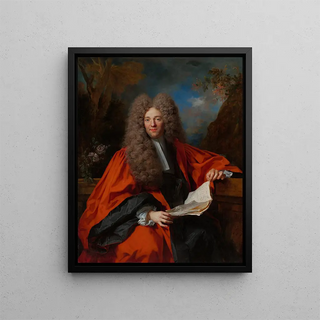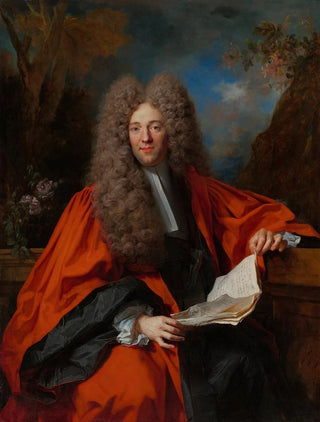Art print | Portrait of Charles-Éléonor Aubry Marquis de Castelnau - Nicolas de Largillière


View from behind

Frame (optional)
Portrait of Charles-Éléonor Aubry Marquis de Castelnau - Nicolas de Largillière – Engaging Introduction
The "Portrait of Charles-Éléonor Aubry Marquis de Castelnau" by Nicolas de Largillière is an iconic artwork that embodies the elegance and refinement of the 18th century. This painting, created by a master of portraiture, immerses us in the aristocratic universe of the era, where every detail is carefully crafted to reflect the status and personality of its subject. Through this portrait, Largillière does not merely capture the appearance of Charles-Éléonor Aubry, but manages to convey an essence, an aura that transcends mere visual representation. The light, colors, and textures combine to create an atmosphere that is both intimate and majestic, inviting the viewer to discover the subtleties of noble life.
Style and uniqueness of the work
The piece stands out for its baroque style, characterized by a masterful use of light and shadow, which imparts a striking depth to the portrait. The face of Charles-Éléonor is illuminated in a way that accentuates his features, while the background, darker, highlights his presence. The sumptuous, richly decorated clothing reflects the fashion of the time and the pronounced taste for luxury. Largillière excels in depicting textures, whether the shiny silk of the attire or the delicacy of accessories; each element contributes to a harmonious composition. The marquis's posture, both dignified and relaxed, reveals a complex personality—strong yet approachable—making the work all the more captivating.
The artist and his influence
Nicolas de Largillière, born in 1656, is one of the most renowned portraitists of his era. His career, spanning several decades, is marked by a stylistic evolution that led him to merge Flemish and French influences. Largillière established himself in the Parisian artistic scene, attracting a prestigious clientele, ranging from nobility to influential court personalities. His portraits, often charged with great expressiveness, reflect a time of profound change, where art

Matte finish

View from behind

Frame (optional)
Portrait of Charles-Éléonor Aubry Marquis de Castelnau - Nicolas de Largillière – Engaging Introduction
The "Portrait of Charles-Éléonor Aubry Marquis de Castelnau" by Nicolas de Largillière is an iconic artwork that embodies the elegance and refinement of the 18th century. This painting, created by a master of portraiture, immerses us in the aristocratic universe of the era, where every detail is carefully crafted to reflect the status and personality of its subject. Through this portrait, Largillière does not merely capture the appearance of Charles-Éléonor Aubry, but manages to convey an essence, an aura that transcends mere visual representation. The light, colors, and textures combine to create an atmosphere that is both intimate and majestic, inviting the viewer to discover the subtleties of noble life.
Style and uniqueness of the work
The piece stands out for its baroque style, characterized by a masterful use of light and shadow, which imparts a striking depth to the portrait. The face of Charles-Éléonor is illuminated in a way that accentuates his features, while the background, darker, highlights his presence. The sumptuous, richly decorated clothing reflects the fashion of the time and the pronounced taste for luxury. Largillière excels in depicting textures, whether the shiny silk of the attire or the delicacy of accessories; each element contributes to a harmonious composition. The marquis's posture, both dignified and relaxed, reveals a complex personality—strong yet approachable—making the work all the more captivating.
The artist and his influence
Nicolas de Largillière, born in 1656, is one of the most renowned portraitists of his era. His career, spanning several decades, is marked by a stylistic evolution that led him to merge Flemish and French influences. Largillière established himself in the Parisian artistic scene, attracting a prestigious clientele, ranging from nobility to influential court personalities. His portraits, often charged with great expressiveness, reflect a time of profound change, where art






